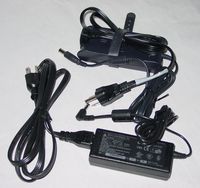Gigabyte's G-Max N411
Construction: Field Tested
|
Charger – The charger for the N411 is an average size, but we would have liked to have seen Gigabyte chose a different power design. Since the power port is on the side of the notebook, the charger has an angled power plug. The best design is to have the power port on the back side of the notebook with a straight power plug. The reason that all the big names have chosen this design is that a side power port/angled plug forces the user to situate the power port facing the wall outlet. If you don't, you might not have enough slack to run the power cord, and if you do have enough cord, running a lot of cable is just unsightly. This is also the reason that most manufacturers put the Ethernet jack on the back side of the notebook.
Display – Gigabyte chose a 14.0" WXGA widescreen display that is capable of native 1280 x 768 with 16 different brightness settings. The highest two settings (16 and 15) are hard to distinguish between, but at the lowest setting, the dimness of the notebook is still enough to use in a dark room without too much eye strain. At its brightest setting on AC power; the display has a natural feel and looks great. On battery power, the brightest setting is a tad dimmer, but there is a large enough difference that we wouldn't watch videos unless connected to AC power.
One unique aspect of this notebook is the "high gloss" or "glare" display type. This is the same type of screen seen on HP's DV1000 or Dell's 700M. These LCD displays are chosen mainly for multimedia notebooks because movies and videos tend to look better on an ultra bright screen, along with the benefit of a wider viewing aspect for the person sitting next to you. Other than that, text is clearer and bright colors appear more vibrant.
The glare effect isn't as high as the two other notebooks we have used that are equipped with this same screen technology, but it is high enough that if a light source is behind you, you can see its reflection on the display.
Fan - Just about all of the fans on current and reasonably current notebooks use a variable speed design, which allows for low rotation speeds when CPU usage/heat are low, and vice versa. The heatsink on the G-Max N411 is fairly large, which we will get to once we get to the blood and guts of the notebook a little later, but the noise level on max is loud enough that you can hear the whirl in a quiet room. It is pretty close to one 80mm x 80mm case fan, but rarely does it reach this volume level. In a quiet room, you would have to put your ear within 3 inches of the notebook's fan (above or below the keyboard), in order to hear the high pitch whine of the fan on low.
Heat – Typically speaking, any large notebook using Centrino technology tends not too get very warm, which happens to be the case with the N411. The only places that get warm after a while is the intake vent on the bottom of the notebook, hard drive heat vent (beneath touchpad), and the WiFi card cover. The temperature of the casing gets about as warm as hot but not scalding tap water, but overall, the top of the notebook stays fairly cool.







